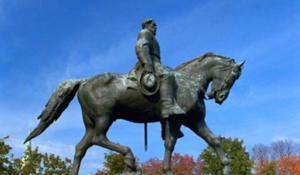Today, there was a memorial service for Heather Heyer, the young woman killed last Friday in Charlottesville, after a car rammed into a crowd of counter-protesters to the white nationalist rally. Living as I do in Richmond, the events in Charlottesville has really hit home. The white nationalists were in Charlottesville to protest the planned removal of Confederate General Robert E. Lee. In Richmond, we have a series of statues of Confederate figures on Monument Avenue. The Mayor of Richmond today announced that he had changed his mind on the statues, and now is supporting their removal. The controversy over Confederate statues follows that over the Confederate flag. For many, these Confederate symbols stand for racism, as they relate to a cause which centered on the maintenance of slavery. Others claim the symbols are part of their identity as Southerners, representing their Southern heritage. The problem with that perspective is that honoring these symbols is deeply offensive to many people, particularly African-Americans, as the symbols – no matter their original meaning or intent – now, in most peoples’ eyes, stand for white supremacy. The Swastika was originally (and still is) a spiritual symbol in India, but no one would accept anyone today wearing a swastika as being anything other than a symbol of Nazism, and therefore of hatred, intolerance, and violence.
Speaking of Nazis, for those of us familiar with German history, the torch march of white nationalists was chilling, as it had so many echoes of similar marches of Nazis in the years before Hitler came to after, and thereafter. Other symbols on view in Charlottesville were also taken from Nazis, the Othala, a pre-Roman rune and the “black sun”. An article in the Deutsche Welle discusses the links of US white nationalist to Nazi Germany. Some of the slogans used in Charlottesville were also creepingly familiar – “Blood and Soil” is a word for word translation of “Blut und Boden”, which as the Deutsche Welle articles states, “expressed the idea dear to Nazis that ethnic purity is based on blood descent and land.”
Slogans and symbols carry deep meanings and often can be integral to a person’s identity – one might think of the what the cross means, for example, for devout Christians. That’s why it’s so important for our leaders to denounce those groups who use symbols like white sheets and hoods or swastikas that divide people and strive to spread their message of hatred. Young people can be easily misled by the facile and false slogans used by hate groups – they need to be contradicted strongly. Heather Heyer posted in social media: “If you’re not outraged, you’re not paying attention”. Let’s hope that many Americans, especially those in power, will express their outrage over the views and actions of the extremists marching in Charlottesville.
An example of that reaction is what has now become the most liked tweet ever, by President Obama, citing Nelson Mandela, “No one is born hating another person because of the color of his skin or his background or his religion…”
